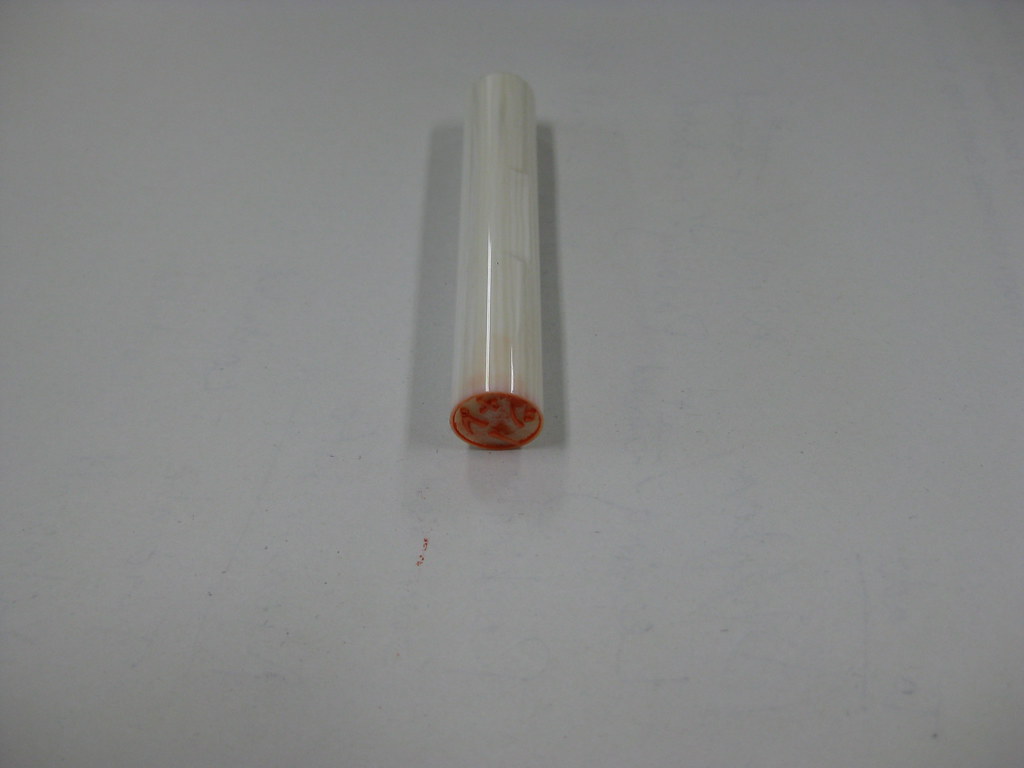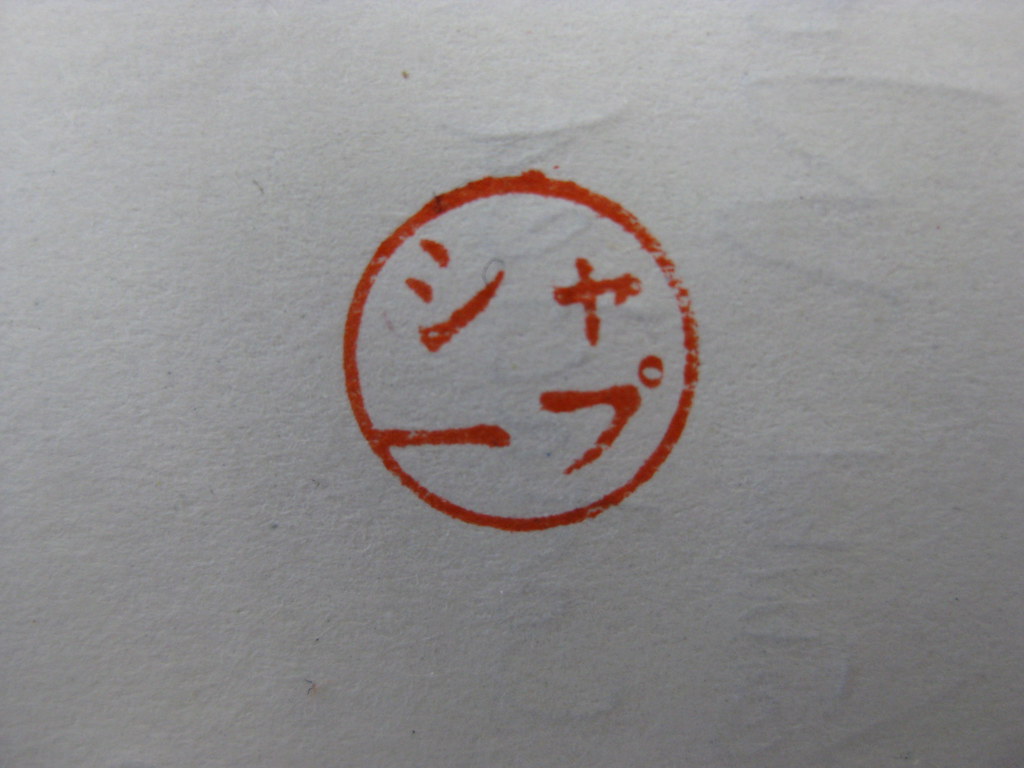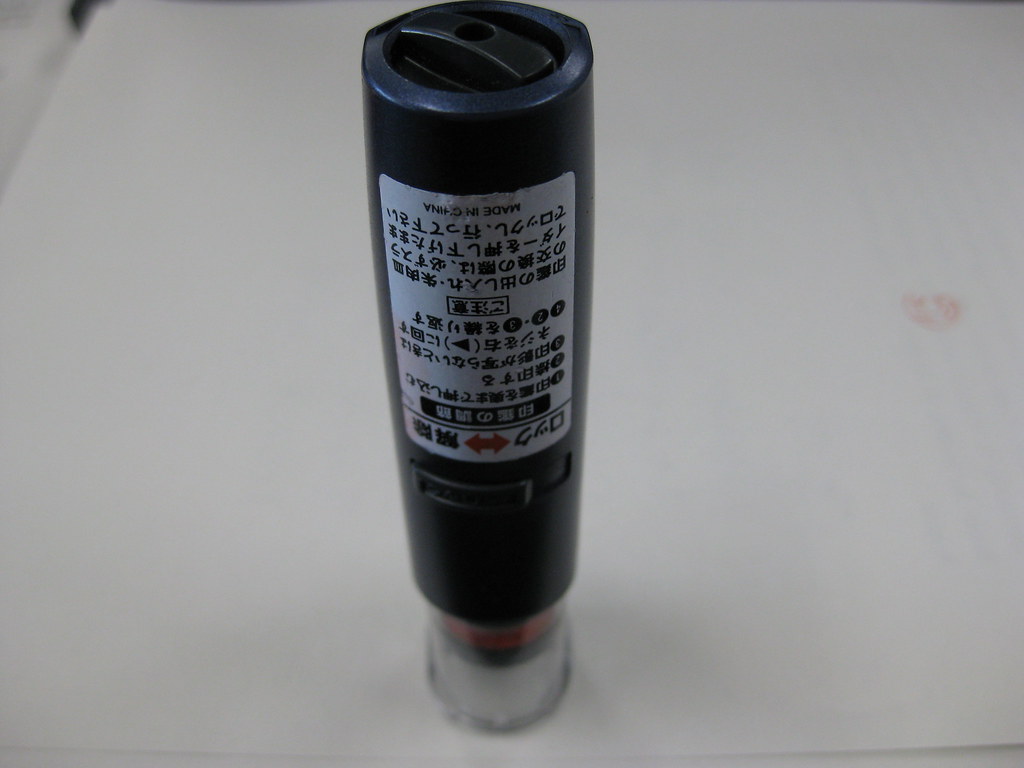Did you know that it's very rare for people in Japan to put a signature on things? Instead, they "stamp" their 印 (いん - in - mark) using what's called an 印鑑 (いんかん - inkan - "seal" or "stamp"), also conversationally called a 判子 (はんこ - hanko). Every business, individual and often even family in Japan has one... including me. Want to see it?
Basically, each 印鑑 is a piece of plastic, wood or other material with a rubber stamp on the bottom that represents your name. Stamping anything is the legal equivalent of a signature, so needless to say it's a big deal. You can't open a bank account, get paid or sign any documents without one!
This is my humble 印鑑, about the size of a felt pen cap. I spared no expense - it's made of white plastic and even has grains painted on to make it look like wood. It cost me about $10 to have made. A lot of デパート (depaato - department stores) sell them ready made, or you can have yours made specially like I did. You need to do this if you want yours in カタカナ (katakana), because the ready-made ones are all in 漢字 (かんじ - kanji). This is what my 印 looks like:
It's read top left to bottom right and says "シャープ" (Sharp). For a 外国人 (がいこくじん - gaikokujin - overseas person), having 印鑑 made is a very flexible affair. You can have them made up in whichever script you like, read top to bottom or in any orientation you prefer. You're also allowed to use whichever of your names you like - I could have had "マイケル" (Michael), for example. Some people prefer to choose 漢字 that matches the reading of their name, but you should always check and make sure you know exactly what they mean before you commit them to your 印鑑 - once you've made it, you're legally stuck with it!
Like most things in Japan, there are a dizzying range of accessories available for your 印鑑. Cases, straps, chains, self-inking pads, holders - everything you can think of (which may not be much). Generally a stamp pad of red ink is available wherever you might need to put your 印 on something, but not always - most cases have a little stamp pad inside them just in case you find yourself without one. I decided to go a bit more fancy:
This is my 印鑑 holder - a case that I don't need to take it out of to stamp. The ink is notoriously messy so I figured not having to handle the 印鑑 itself would help me avoid red fingers. It also locks shut so I don't repeatedly stamp the inside of my pocket when I walk around. Apparently the self-inking stamp pad inside is good for more than 1000 stamps - I wonder if I'll use it up?
One of the first questions I asked about the 印鑑 system, and one you might be thinking now, is how they avoid identity theft. Surely someone could go and have one made up with another person's name and stamp away to their heart's content, right? Well, yes and no apparently. Unlike my rather basic 印鑑, the more expensive ones use extremely complicated scripts and patterns, to the point where the 漢字 in someone's name is an almost unrecognisable sprawl of lines. 印鑑 shops are also bound to never create the same 印鑑 twice, so if you lose yours I assume you have to go through a very complicated process to have it replaced. Given that, the chance of having one made up that happens to be exactly the same size, shape and pattern as another is almost nil.
That doesn't stop people from being extra careful though - people spend hundreds, if not thousands of dollars on 印鑑 if they're for important or ceremonial purposes - they can be made out of very expensive wood, ivory or whalebone, patterned and sized as uniquely as fingerprints and kept under lock and key when they're not in use. A bit harder than copying a signature, wouldn't you agree?



No comments:
Post a Comment
If you have any questions or additions, I would love to hear from you. I may not know the answer, but I'll do my best to find out in any case! You can post anonymously if you like, but abusive/unintelligible/inappropriate comments will not be published.